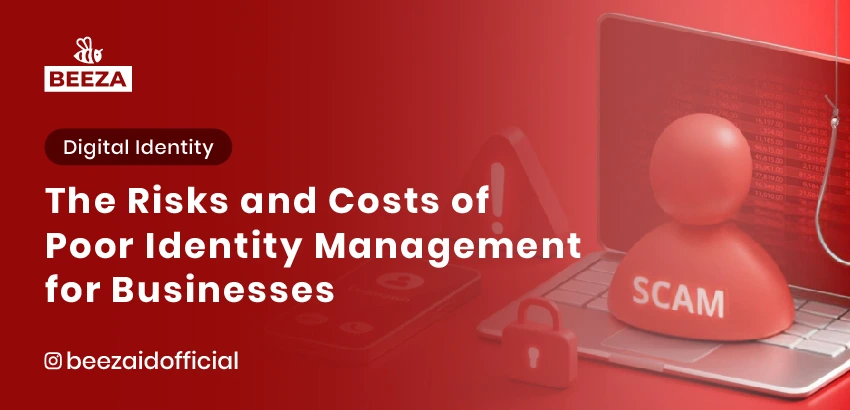
What is Poor Identity Management? Does your business have effective identity management? In the digital era, where data is a top asset, poor identity management can jeopardize security, reputation, and customer trust. Mismanagement of identity carries significant risks, from security breaches to a loss of customer loyalty. This article delves into the risks of weak identity management, its impact on businesses, and steps to mitigate these risks.
What is Poor Identity Management?
Identity management is the process of ensuring that individuals or entities accessing data or services are who they claim to be. It includes access control, authentication, and user activity tracking to secure information and ensure access is only granted to authorized individuals.
Poor identity management involves weak or lax processes that allow unauthorized access, leading to security risks. Some indicators of poor identity management include:
- Weak or Non-Unique Credentials: Simple or reused passwords across multiple platforms.
- Lack of Multi-Factor Authentication (MFA): Systems relying solely on one authentication factor, increasing the risk of unauthorized access.
- Ineffective Tracking Processes: Systems that fail to log user activity are vulnerable to unauthorized access.
The Negative Impact of Poor Identity Management on Businesses
1. Security and Financial Risks
Insufficient identity management significantly increases the risk of cyber-attacks. With data more valuable than ever, cybercrime can lead to sensitive data leaks and privacy breaches. Financial consequences of these breaches are substantial, with recovery costs and customer loss potentially reaching hundreds of thousands to millions of dollars.
- Direct Costs: These include data recovery, forensic investigation, and security consulting fees.
- Indirect Costs: Loss of revenue from customers who lose trust and turn to competitors.
2. Reputational Damage and Loss of Customer Trust
In a competitive business environment, reputation is everything. Major data breaches or security incidents can lead to a loss of customer trust, which is often challenging to regain. When customers doubt the security of your system, they may consider switching to other providers they perceive as safer.
- Decline in Customer Trust: Lack of confidence in the business’s ability to protect data.
- Impact on Loyalty: Customers are unlikely to return if they feel their personal information is at risk.
3. Compliance and Legal Risks
Strict data protection laws, such as GDPR and CCPA, require businesses to handle user data carefully. Failing to comply with these regulations can result in significant fines and lengthy legal proceedings.
- Financial Penalties: GDPR violations, for example, can result in fines up to 4% of a company’s annual revenue.
- Litigation and Legal Action: Disadvantaged customers may file lawsuits, increasing operational costs.
Mitigation Strategies to Prevent Poor Identity Management Risks
1. Implement Multi-Factor Authentication (MFA)
Multi-factor authentication is one of the most effective steps to reduce the risk of unauthorized access. By combining multiple authentication factors (such as passwords, SMS codes, or biometrics), businesses can ensure that access is only granted to authorized individuals.
- Benefits of MFA: Enhances access security by reducing password-based hacking risks.
- How to Implement: Offer MFA as a standard option for all users, with biometric options like fingerprint or facial recognition.
2. Strengthen Security Policies and Training
Enforce strict data use and identity management policies consistently across the company. Regular training is essential to ensure all employees understand their role in maintaining data security.
- Security Awareness Training: Educate employees on the latest hacking techniques and best practices.
- Password Policy: Establish policies for periodic password updates and discourage the use of weak or repeated passwords.
3. Conduct Regular Security Audits
Regular security audits enable businesses to detect potential security gaps before they can be exploited. By evaluating systems regularly, businesses can ensure they meet the security standards expected by customers and regulators.
- Regular System Evaluation: Identify areas needing improvement in identity management.
- Risk Assessment: Determine potential risks by testing system vulnerabilities and addressing any weaknesses.
4. Use Automated Identity Management Tools
Investing in advanced identity management tools helps streamline user access management. Automated solutions allow companies to monitor and control identity activity without manual checks, reducing human error.
- Benefits of Automation: Facilitates monitoring of suspicious activity and enables more efficient tracking.
- Recommended Tools: Tools that integrate with company systems to monitor logins, access, and user actions.
Future Trends in Identity Management
With data security becoming increasingly critical, several technology trends are set to reshape how businesses manage identity. Here are some innovations to watch:
- Blockchain for Decentralized Identity: Empowers users with full control over their data, offering stronger security.
- Artificial Intelligence (AI) and Machine Learning (ML): Helps analyze activity patterns to detect suspicious behavior.
- Biometric Identification: Facial or fingerprint recognition as authentication improves security and ease of use.
Key Takeaways
- Risks of Poor Identity Management: Leads to severe security, financial, and legal risks.
- Impact on Customer Trust: Customers expect data security; otherwise, a company’s reputation may suffer.
- Mitigation Strategies: Multi-factor authentication, employee training, regular audits, and automated tools help reduce risks.
- Future Innovations: Technologies like blockchain and biometrics hold potential to enhance security and identity management.
To learn more about the best identity management practices for your business, visit our website and discover solutions tailored to your needs.